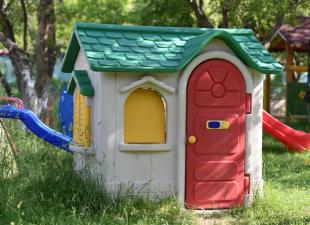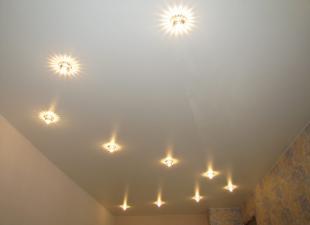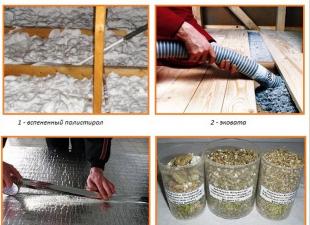When performing design projects in new buildings, not to mention secondary housing, customers often face the problem of low ceilings. You should not despair: any ceiling can be "raised", albeit visually. Finding out how to do it.
- 1 of 1
On the picture:
Low ceilings (by this we mean a height of 2.4-2.6 meters) is a problem in many typical apartments. With them, the room may seem darker, cramped, closed. However, coping with the task is not so difficult if you competently take on the repair. In this article, I will discuss practical ways to visually increase the height of the ceiling.
1. Choosing a color
White or beige, pastel, dull colors - this is the right choice to visually increase the height of the ceiling. The only difference is in creating an interior in cold or warm colors. White color allows you to perfectly expand the space. When using several colors in the interior, it is important to remember the rule: the color of the walls cannot be darker than the color of the ceiling. If you use a gradient when painting the walls, then the top of the wall should be made lighter than the bottom.

- 1 of 1
On the picture:
2. Gloss or mat
When choosing paint for the ceiling, it is better to prefer gloss, since glossy surfaces, creating a reflection, increase the space, which means that the ceiling in the living room will appear higher.
3. Ceiling
There are also 3D photo wallpapers that, when glued, create an unusual ceiling design in the living room - with the effect of the sky.
In the photo: Brave wallpaper P170501-9 by Mr Perswall.
If, nevertheless, you really want to become the owner of a two-level ceiling, and the height does not allow, then you can make not too wide drops around the perimeter of the room, and make the inner part of the ceiling higher. In this version, visually, most of the ceiling will be relatively high, and the drops around the perimeter can be decorated with spotlights. The central, higher part of the ceiling can be illuminated with LED lighting. You can also lower only one side of the ceiling by placing spotlights in it, and leave the main level higher.
For storing clothes, a floor-to-ceiling wardrobe with mirrored doors would be an excellent solution.
Pictured: Napol's Zero 2 wardrobe.
Furniture in the apartment should be visually light, elegant, preferably light shades. Too high and massive furniture will "crush", so it is better to choose low models.
8. Kitchen
As for kitchen furniture, to visually raise the ceiling, the distance from the wall cabinets to it must be minimized. It is better to choose a headset finish in light colors. An interesting option is a combination of darker base cabinets with wall cabinets in light shades. For example, with a white glossy finish.
9. Wallpaper
If you want to choose wallpaper with some kind of ornament or pattern, it is better to use a longitudinal pattern that is not too bright in color. The most common solution is wallpaper with vertical alternating stripes of various thicknesses and colors.
10. Decorating
It is better to use large vertical mirrors: for example, a floor mirror in an elegant, lightweight frame will look beautiful in the interior.
Photo: Agrip mirror by Tonin casa.
In the interior of the apartment, you can use mirrors or glossy surfaces. The mirror will allow not only to increase the height of the ceiling, but also to visually expand the space of the room.
Do not overuse a large number of framed photos, paintings or brought souvenirs on the shelves. They will create a sense of congestion in the room.
Instead of several small paintings, it is better to choose one - a larger one. Moreover, it is better to choose a canvas with a vertical rather than horizontal composition. If you do choose several small paintings, hang them just above eye level.
11. Curtains
The curtain rod should be located as close to the ceiling as possible to make the curtain look as long as possible. If you have lowered the ceiling, you can completely hide the cornice in the plane of the ceiling. Curtains should be chosen with a vertical pattern, but you should not take everything literally.

- 1 of 2
On the picture:
They do not have to be strictly vertical stripes - an ornament with a longitudinal pattern is quite suitable. Do not use too bright "flashy" colors.
Comment on FB Comment on VK
Also in this section

There are many ways to save money on renovations, not only apartments, but even houses. Olga Dukven, the head of the Domostroy design studio, tells in detail how to do this.


In this article, Pavel Gerasimov from the Geometrium workshop will consider the pros and cons of natural materials, their practicality and the ability to fit into the interior.

We will tell you what an interior designer needs to know about modern acoustic systems so as not to step on the throat of his own song and speak the same language with the installer.

Pavel Gerasimov from the Geometrium workshop on how to choose the style of an apartment for a young family, how to properly plan a budget for the implementation of the desired solutions and how to think over the layout.

Pavel Gerasimov, designer and co-director of the Geometrium workshop, tells in detail about where saving is meaningless and what is worth spending money on in the interior.

Designer Anna Valder talks about Scandinavian style, white winter, black nights and interiors in Northern Europe. And she is not only a theoretician, but, above all, a practitioner with a large portfolio!

If the issue of lighting was not well thought out at the stage of repair and additional electrical conclusions cannot be drawn, functional "mobile" lamps will help to solve the problem.

The transitional style is one of the current interior trends. It combines all the best from the past eras and the technological future. This explains its exceptional popularity.

Not every designer lamp can be called a "light sculpture". Let's talk about the brightest representatives of this rare phenomenon in the field of lighting.
 parlini.ru Repair of an apartment, a summer residence and a house.
parlini.ru Repair of an apartment, a summer residence and a house.


